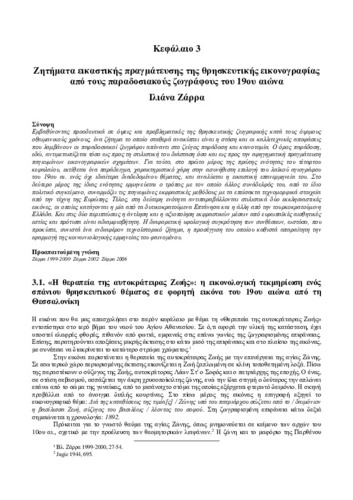| Title Details: | |
|
Issues of visual debate of the religious iconography of the traditional painters of the 19th century |
|
| Authors: |
Zarra, Iliana |
| Reviewer: |
Sampanikou, Evangelia |
| Subject: | HUMANITIES AND ARTS > HISTORY > SPECIALIZED HISTORIES > CULTURAL HISTORY LAW AND SOCIAL SCIENCES > ANTHROPOLOGY (NON PHYSICAL) > SOCIAL AND CULTURAL ANTHROPOLOGY > ANTHROPOLOGY AND HISTORY LAW AND SOCIAL SCIENCES > ANTHROPOLOGY (NON PHYSICAL) > SOCIAL AND CULTURAL ANTHROPOLOGY > ANTHROPOLOGY AND ART LAW AND SOCIAL SCIENCES > ANTHROPOLOGY (NON PHYSICAL) > SOCIAL AND CULTURAL ANTHROPOLOGY > ANTHROPOLOGY OF MATERIAL CULTURE LAW AND SOCIAL SCIENCES > ANTHROPOLOGY (NON PHYSICAL) > SOCIAL AND CULTURAL ANTHROPOLOGY > ANTHROPOLOGY AND ARCHAEOLOGY HUMANITIES AND ARTS > HISTORY > GENERAL HISTORY, THEORY > OTTOMAN HISTORY HUMANITIES AND ARTS > HISTORY > GENERAL HISTORY, THEORY > MODERN HISTORY HUMANITIES AND ARTS > HISTORY > SPECIALIZED HISTORIES > HISTORY OF ART |
| Keywords: |
Neohellenic Art
Post-byzantine Civilization Secular Painting Relations Between Secular And Religious Painting Recurarization Of Religious Painting Naive Art Late Ottoman History |
| Description: | |
| Abstract: |
Gaining insight progressively into aspects and problematic practices of religious painting during the late ottoman times, an issue, which constantly emerges, is the stance and the artistic decisions that traditional painters receive towards the pair between tradition and innovation. The term tradition, here, is dealt with regard both to its stylistic dimension and its narrative debate of established iconographic forms. For this, in the first part of the first section of the fourth chapter, one example is exposed, distinctive thanks to the unusual choice of the lay icon painter of the 19th century, of one not particularly widespread theme where its visual reinterpretation is being analysed. In the second part of the same section the way is interpreted in which another fellow painter, from the same political context, connects the established expressive methods with the extraneous art morphic elements taken of Europe’s art. In the end, in the second section two ecclesiastical icons are being contrasted stylistically, which one of them comes from the western occupied Ionian Islands and the other comes from the Turkish occupied Greece. In both cases, the extraction and the utilisation of expressive means of European aesthetical sources and standards is undeniable. However, the different stylistic constitution of the compositions, which emerges, constitutes an interesting art-historical issue, whereof its approach necessitates the application of the sociological interpretation of the phenomenon.
|
| Linguistic Editors: |
Karampalis, Spyridon |
| Technical Editors: |
Zinas, Nikolaos |
| Graphic Editors: |
Koumartzis, Nikolaos |
| Type: |
Chapter |
| Creation Date: | 2015 |
| Item Details: | |
| License: |
http://creativecommons.org/licenses/by-nc-nd/3.0/gr |
| Spatial Coverage: |
Mainland Greece |
| Temporal Coverage: |
19th centure |
| Handle | http://hdl.handle.net/11419/3927 |
| Bibliographic Reference: | Zarra, I. (2015). Issues of visual debate of the religious iconography of the traditional painters of the 19th century [Chapter]. In Merantzas, C., Zarra, I., & Tsiodoulos, S. 2015. FROM POST-BYZANTINE TO MODERN CIVILIZATION [Undergraduate textbook]. Kallipos, Open Academic Editions. https://hdl.handle.net/11419/3927 |
| Language: |
Greek |
| Is Part of: |
FROM POST-BYZANTINE TO MODERN CIVILIZATION |
| Number of pages |
27 |
| Publication Origin: |
Kallipos, Open Academic Editions |


